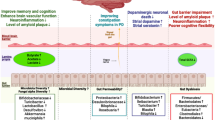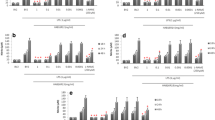Abstract
Objective
To determine the effect of medicated serum of Chinese herbal compound Naofucong (脑复聪, NFC) on the microglia BV-2 cells viability and the transcription and expression of interleukin-6 (IL-6) and tumor necrosis factor α (TNF-α) in microglia BV-2 cells to further explore the mechanisms underlying the protective effect of NFC on inflammatory process induced by high glucose.
Methods
The microglia BV-2 cells incubated in vitro were divided into different groups: the control group (25 mmol/L glucose), the model group (75 mmol/L glucose), high glucose media containing different dose medicated serum of NFC. After being cultured for 24 h, changes in IL-6 and TNF-α were measured by quantitative real-time polymerase chain reaction and enzyme-linked immunosorbent assay. The expression of surface marker CD11b of activated microglia was measured by confocal laser scanning microscope and Western blot. Nuclear factor-κB (NF-κB) p-p65 expression was analyzed by Western blot.
Results
The model group obviously increased the expression of microglial surface marker CD11b and NF-κB p-p65 (all P<0.01), induced a signifificant up-regulation of release and the mRNA expression of IL-6 and TNF-α (P<0.01 or P<0.05). The medicated serum of NFC could obviously down-regulate the transcription and expression of surface marker CD11 b and NF-κB p-p65 (all P<0.01), and inhibit the mRNA and protein expression (P<0.01 or P<0.05) of inflflammatory cytokines, such as IL-6 and TNF-α, in microglia BV-2 cells cultured with high glucose for 24 h.
Conclusions
The inhibition of microglial activation and IL-6 and TNF-α expression induced by high glucose may at least partly explain NFC therapeutic effects on diabetes-associated cognitive decline diseases. Its underlying mechanism could probably be related to the inhibition of NFC on NF-κB phosphorylation.
Similar content being viewed by others
References
Wild S, Roglic G, Green A, Sicree R, King H. Global prevalence of diabetes: estimates for the year 2000 and projections for 2030. Diabetes Care 2004;27:1047–1053.
Cukierman T, Gerstein HC, Williamson JD. Cognitive decline and dementia in diabetes: systematic overview of prospective observational studies. Diabetologia 2005;48:2460–2469.
Abbatecola AM, Paolisso G. Relationship between baseline glycemic control and cognitive function in individuals with type 2 diabetes and other cardiovascular risk factors: the Action to Control Cardiovascular Risk in Diabetes-Memory in Diabetes (ACCORD-MIND) Trial. Diabetes Care 2009;32:102–103.
Bruce DG, Davis WA, Casey GP, Starkstein SE, Clarnette RM, Foster JK, et al. Predictors of cognitive impairment and dementia in older people with diabetes. Diabetologia 2008;51:241–248.
Tiehuis AM, van der Graaf Y, Visseren FL, Vincken KL, Biessels GJ, Appelman AP, et al. Diabetes increases atrophy and vascular lesions on brain MRI in patients with symptomatic arterial disease. Stroke 2008;39:1600–1603.
De Jong RN. The nervous system complications in diabetes mellitus with special reference to cerebrovascular changes. J Nerv Ment Dis 1950;111:181–206.
Mijnhout GS, Scheltens P, Diamant M, Biessels GJ, Wessels AM, Simsek S, et al. Diabetic encephalopathy: a concept in need of a definition. Diabetologia 2006;49:1447–1448.
Strachan MW, Reynolds RM, Frier BM, Mitchell RJ, Price JF. The role of metabolic derangements and glucocorticoid excess in the aetiology of cognitive impairment in type 2 diabetes: implications for future therapeutic strategies. Diabetes Obes Metab 2009;11:407–414.
Rogers J, Mastroeni D, Leonard B, Joyce J, Grover A. Neuroinflammation in Alzheimer’s disease and Parkinson’s disease: are microglia pathogenic in either disorder? Int Rev Neurobiol 2007;82:235–246.
Schmidt MI, Duncan BB, Sharrett AR, Lindberg G, Savage PJ. Offenbacher S, et al. Markers of inflammation and prediction of diabetes mellitus in adults (Atherosclerosis Risk in Communities study): a cohort study. Lancet 1999;353:1649–1652.
Marioni RE, Strachan MW, Reynolds RM, Lowe GD, Mitchell RJ, Fowkes FG, et al. Association between raised inflammatory markers and cognitive decline in elderly people with type 2 diabetes: the Edinburgh Type 2 Diabetes Study. Diabetes 2010;59:710–713.
Kreutzberg GW. Microglia: A sensor for pathological events in the CNS. Trends Neurosci 1996;19:312–318.
Xu HY, Zhang MR, Guo SS, Zuo PP. Effects of Naoucong Grain on brain NMDA receptor in experimental dementia mice. Chin J Rehabil Theory Pract (Chin) 2003;9:596–598.
Zhang MR, Guo SS, Xu HY, Zuo PP. Study on the mechanism of Naofucong Granule in improving memory of cerebral ischemic mice. Chin J Integr Tradit West Med (Chin) 2004;24:147–149.
Zhang MR, Guo SS, Xu HY, Zuo PP, Yang N. Effect of Naofucong Granule on cerebral SOD and GSH-Px in cerebral ischemic mice. Chin J Prevent Med (Chin) 2004;5:324–326.
Zhang MR, Xu HY, Guo SS, Zuo PP. Studies on the protective effect of drug serum taken from rats administered with Naofucong in PC12 cell ischemic model. Chin J Rehabil Theory Pract (Chin) 2003;9:598–599.
Fu S, Zhang MR. Influences of Naofucong on the learning and memory abilities and insulin-like growth factor-I contents in hippocampus CA1 region of diabetes rats. J China Medl Univ (Chin) 2009;38:677–680.
Wang B, Zhu L, Qi C. Primary study on the application of serum pharmacology in Chinese traditional medicine. Colloid Surf B Biointerf 2005;43:194–197.
Zhang H, Xing WW, Li YS, Zhu Z, Wu JZ, Zhang QY, et al. Effects of traditional Chinese herbal prepration on osteoblasts and osteoclasts. Maturitas 2008;61:334–339.
Tashino S. “Serum pharmacology” and “Serum pharmaceutical chemistry”: from pharmacology of Chinese traditional medicines to start a new measurement of drug concentration in blood. Ther Drug Monit Res 1988;5:54–64.
Chourbaji S, Urani A, Inta I, Sanchis-Segura C, Brandwein C, Zink M, et al. IL-6 knockout mice exhibit resistance to stress-induced development of depression-like behaviors. Neurobiol Dis 2006;23:587–594.
Sparkman NL, Buchanan JB, Heyen JR, Chen J, Beverly JL, Johnson RW. Interleukin-6 facilitates lipopolysaccharideinduced disruption in working memory and expression of other proinflammatory cytokines in hippocampal neuronal cell layers. J Neurosci 2006;26:10709–10716.
Marsland AL, Petersen KL, Sathanoori R, Muldoon MF, Neumann SA, Ryan C, et al. Interleukin-6 covaries inversely with cognitive performance among middle-aged community volunteers. Psychosom Med 2006;68:895–903.
O’Donovan A, Hughes BM, Slavich GM, Lynch L, Cronin MT, O’Farrelly C, et al. Clinical anxiety, cortisol and interleukin-6: evidence for specificity in emotion-biology relationships. Brain Behav Immun 2010;24:1074–1077.
André C, O’Connor JC, Kelley KW, Lestage J, Dantzer R, Castanon N. Spatio-temporal differences in the profile of murine brain expression of proinflammatory cytokines and indoleamine 2,3-dioxygenase in response to peripheral lipopolysaccharide administration. Neuroimmunol 2008;200:90–99.
Marsland AL, Gianaros PJ, Abramowitch SM, Manuck SB, Hariri AR. Interleukin-6 covaries inversely with hippocampal grey matter volume in middle-aged adults. Biol Psychiatry 2008;64:484–490.
Hein AM, Stasko MR, Matousek SB, Scott-McKean JJ, Maier SF, Olschowka JA, et al. Sustained hippocampal IL-1 beta overexpression impairs contextual and spatial memory in transgenic mice. Brain Behav Immun 2010;24:243–253.
Lee JW, Lee YK, Yuk DY, Choi DY, Ban SB, Oh KW, et al. Neuro-inflammation induced by lipopolysaccharide causes cognitive impairment through enhancement of beta-amyloid generation. Neuroinflammation 2008;5:37.
Noble F, Rubira E, Boulanouar M, Palmier B, Plotkine M, Warnet JM, et al. Acute systemic inflammation induces central mitochondrial damage and mnesic deficit in adult Swiss mice. Neurosci Lett 2007;424:106–110.
Liu YW, Zhu X, Lu Q, Wang JY, Li W, Wei YQ, et al. Total saponins from Rhizoma Anemarrhenae ameliorate diabetes-associated cognitive decline in rats: involvement of amyloid-beta decrease in brain. J Ethnopharmacol. 2012;6:194–200.
Neumann H, Schweigreiter R, Yamashita T, Rosenkranz K, Wekerle H, Barde YA. Tumor necrosis factor inhibits neurite outgrowth and branching of hippocampal neurons by a rhodependent mechanism. Neurosci 2002;22:854–862.
Sima AA. New insights into the metabolic and molecular basis for diabetic neuropathy. Cell Mol Life Sci 2003,60:2445–2464.
Makimattila S, Malmberg-Ceder K, Hakkinen AM, Vuori K, Salonen O, Summanen P, et al. Brain metabolic alterations in patients with type 1 diabeteshyperglycemia-induced injury. J Cereb Blood Flow Metab 2004,24:1393–1399.
Quan Y, Jiang CT, Xue B, Zhu SG, Wang X. High glucose stimulates TNFa and MCP-1 expression in rat microglia via ROS and NF-?B pathways. Acta Pharmacol Sin 2011;32:188–193.
Du X, Mao R, Liu Y, Li Y, Shan Y. Gastrodine represses expression of IL-1 beta, IL-6 induced by hyperglycemia in gitter cells. China J Chin Materia Med (Chin) 2009;34:1535–1539.
Klein JP, Hains BC, Craner MJ, Black JA, Waxman SG. Apoptosis of vasopressinergic hypothalamic neurons in chronic diabetes mellitus. Neurobiol Dis 2004;15:221–228.
Li ZG, Zhang W, Sima AA. C-peptide enhances insulinmediated cell growth and protection against high glucoseinduced apoptosis in SH-SY5Y cells. Diabetes Metab Res Rev 2003;19:375–385.
Chan YC, Wang MF, Chang HC. Polygonum multiflorum extracts improve cogniftive performance in senescence accelerated mice. Am J Chin Med 2003;31:171–179.
Author information
Authors and Affiliations
Corresponding author
Additional information
Supported by Beijing Natural Science Foundation (No. 7142129), and Beijing Science and Technology Project of Traditional Chinese Medicine (No. JJ2014-50), China
Rights and permissions
About this article
Cite this article
Jing, Gc., Zhang, Mr., Ji, C. et al. Effect of Chinese herbal compound Naofucong (脑复聪) on the inflammatory process induced by high glucose in BV-2 cells. Chin. J. Integr. Med. 22, 832–839 (2016). https://doi.org/10.1007/s11655-016-2256-0
Received:
Published:
Issue Date:
DOI: https://doi.org/10.1007/s11655-016-2256-0




